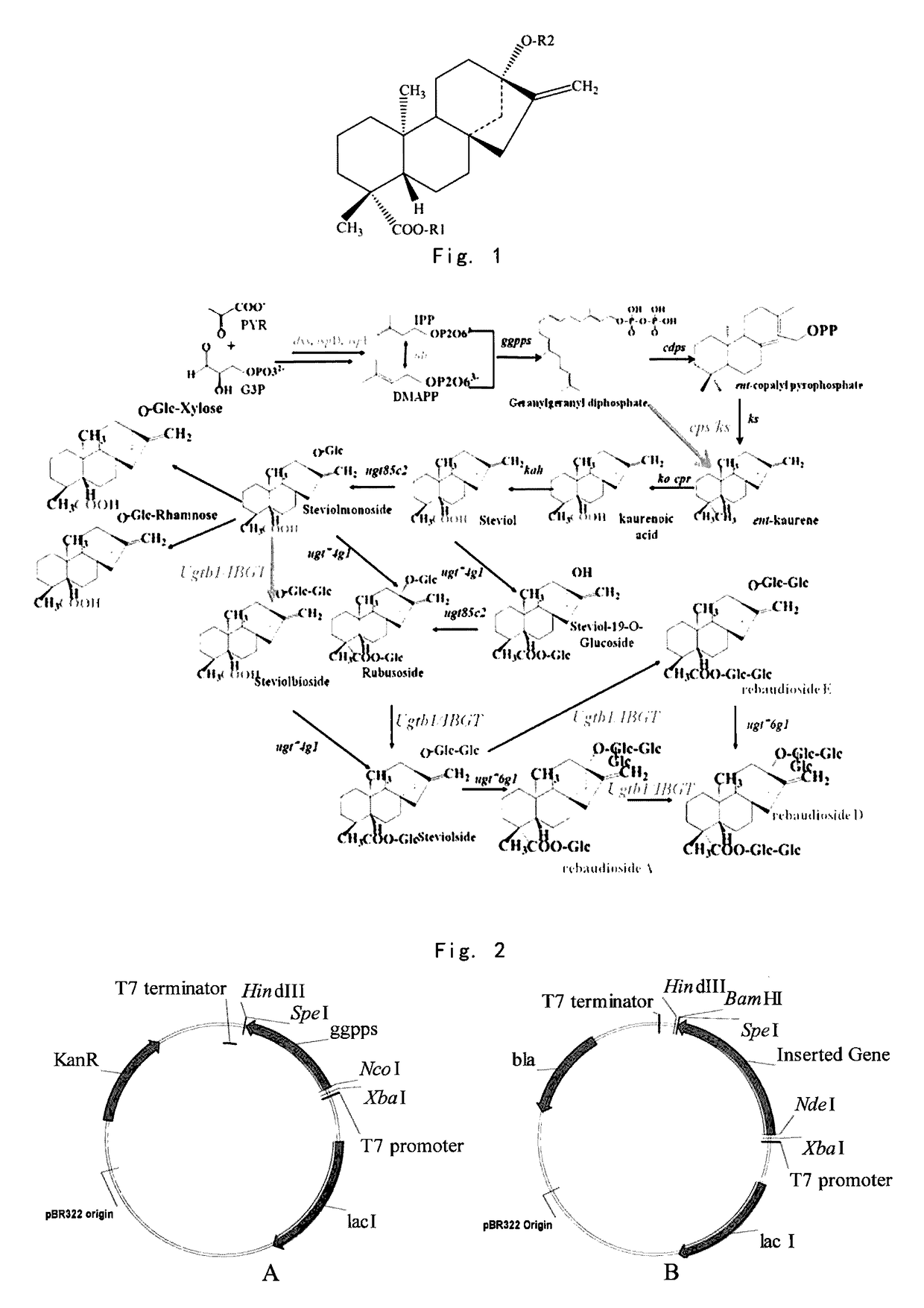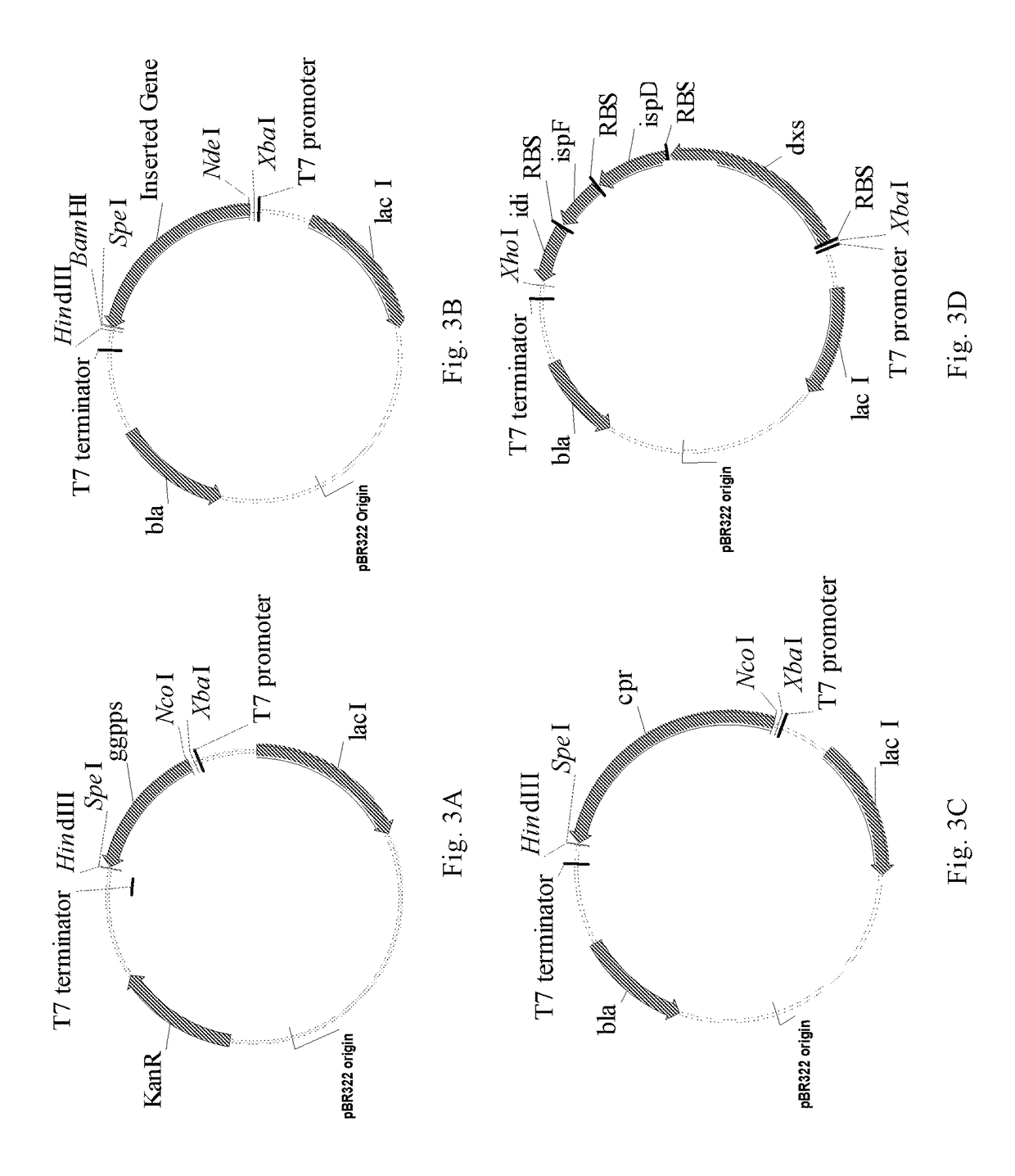Method for producing stevioside compounds by microorganism
a technology of steviol glycoside and microorganisms, which is applied in the field of synthesizing biology, can solve the problems of low conversion efficiency of raw materials, low purity of extracted products, and inability to synthesis rebaudiosides by heterologous organisms
- Summary
- Abstract
- Description
- Claims
- Application Information
AI Technical Summary
Benefits of technology
Problems solved by technology
Method used
Image
Examples
example 1
Obtaining the Proteins Used in the Heterologous Biosynthesis of a Steviol Glycoside
[0198]Gene sources and synthesis of the geranylgeranyl diphosphate synthase, ent-copalyl diphosphate synthase, ent-kaurene synthase, bifunctional ent-kaurene synthase, ent-kaurene oxidase, kaurenoic acid-13α-hydroxylase, UGT85C2 glycosyltransferase, UGTB1 glycosyltransferase, UGT74G1 glycosyltransferase, UGT76G1 glycosyltransferase, and cytochrome P450 redox protein involved in the synthesis of a steviol glycoside, rebaudioside A.
[0199]Geranylgeranyl diphosphate synthase (GGPPS) from Taxus canadensis and Stevia rebaudiana; ent-copalyl diphosphate synthase (CDPS) from Stevia rebaudiana and Bradyrhizobium japonicum; ent-kaurene synthase (KS) from Stevia rebaudiana and Bradyrhizobium japonicum; bifunctional ent-kaurene synthase (CPS / KS) from Physcomitrella patens and Gibberella fujikuroi; ent-kaurene oxidase (KO) from Stevia rebaudiana, Gibberella fujikuroi, Arabidopsis thaliana and Bradyrhizobium japoni...
example 2
Construction of the Prokaryotic Expression Vector
[0233]The optimized genes of geranylgeranyl diphosphate synthase, ent-copalyl diphosphate synthase, ent-kaurene synthase, bifunctional ent-kaurene synthase, ent-kaurene oxidase, kaurenoic acid-13α-hydroxylase, UGT85C2 glycosyltransferase, UGT74G1 glycosyltransferase, UGT76G1 glycosyltransferase and cytochrome P450 redox protein were cloned into related plasmids to construct the gene expression vectors used in the rebaudioside A synthesis pathway in bacterium.
[0234]A SpeI restriction site was inserted after the terminator codon TAA of the optimized ggpps gene, then the resultant gene was cloned into plasmid pET28a (Novagen) at the NcoI / HindIII restriction site to produce pET28a-ggpps (FIG. 3A).
[0235]The SpeI site was inserted after the terminator codon TAA of the optimized cdps, cps / ks, ks, ko, kah, ugt85c2, ugtb1, ugt74g1, and ugt76g1, respectively, then the resultant genes were cloned into pET21a (Novagen), respectively, at the NdeI / ...
example 3
Construction of the Fungal Expression Vectors
[0240]The optimized genes for the geranylgeranyl diphosphate synthase, ent-copalyl diphosphate synthase, ent-kaurene synthase, bifunctional ent-kaurene synthase, ent-kaurene oxidase, kaurenoic acid-13α-hydroxylase, UGT85C2 glycosyltransferase, UGTB1 glycosyltransferase, UGT74G1 glycosyltransferase, UGT76G1 glycosyltransferase, and cytochrome P450 redox protein, obtained in Example 1, were cloned into corresponding plasmids to construct gene expression plasmids for synthesizing rebaudioside A in fungus.
[0241]Firstly, the initial pAO815 vector (Invitrogen) was modified by introducing BamHI and XhoI restriction sites after pAO815 terminator by site-directed mutagenesis PCR. The modified pAO815 was named pSY01. The BamHI site in the pET28a-ggpps gene was removed by site-directed mutagenesis PCR and the BglII site in the pET21a-ks gene was removed by site-directed mutagenesis PCR.
[0242]The ggpps gene was amplified by PCR by using the pET28a-gg...
PUM
| Property | Measurement | Unit |
|---|---|---|
| volume | aaaaa | aaaaa |
| flow rate | aaaaa | aaaaa |
| temperature | aaaaa | aaaaa |
Abstract
Description
Claims
Application Information
 Login to View More
Login to View More - R&D
- Intellectual Property
- Life Sciences
- Materials
- Tech Scout
- Unparalleled Data Quality
- Higher Quality Content
- 60% Fewer Hallucinations
Browse by: Latest US Patents, China's latest patents, Technical Efficacy Thesaurus, Application Domain, Technology Topic, Popular Technical Reports.
© 2025 PatSnap. All rights reserved.Legal|Privacy policy|Modern Slavery Act Transparency Statement|Sitemap|About US| Contact US: help@patsnap.com



